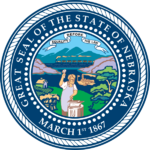Nebraska Supreme Court elections, 2022
| 2022 State Judicial Elections | |
|---|---|
2023 »
« 2021
| |
 | |
| Overview | |
| Supreme Courts Overview | |
| Appellate Courts Overview | |
| View judicial elections by state: | |
The terms of four Nebraska Supreme Court justices expired on January 5, 2023. The four seats were up for retention election on November 8, 2022. Judicial officeholders had until August 1, 2022, to file for retention.[1]
Nebraska was one of 30 states that held elections for state supreme court in 2022. That year, 84 of the 344 seats on state supreme courts were up for election. Of those, 64 were held by nonpartisan justices, 13 were held by Republican justices, and eight were held by Democratic justices. For more on the partisan affiliation of state supreme court justices, click here. For an overview of state supreme court elections in 2022, click here.
Candidates and results
Chief Justice: Heavican's seat
Nebraska Supreme Court Chief Justice, Michael Heavican's seat
Michael Heavican was retained to Chief Justice of the Nebraska Supreme Court on November 8, 2022 with 71.3% of the vote.
Retention Vote |
% |
Votes |
|||
| ✔ | Yes |
71.3
|
375,342 | ||
No |
28.7
|
151,269 | |||
Total Votes |
526,611 | ||||
|
|
District 3: Cassel's seat
Nebraska Supreme Court District 3, William Cassel's seat
William Cassel was retained to District 3 of the Nebraska Supreme Court on November 8, 2022 with 72.4% of the vote.
Retention Vote |
% |
Votes |
|||
| ✔ | Yes |
72.4
|
67,276 | ||
No |
27.6
|
25,648 | |||
Total Votes |
92,924 | ||||
|
|
District 4: Papik's seat
Nebraska Supreme Court District 4, Jonathan Papik's seat
Jonathan Papik was retained to District 4 of the Nebraska Supreme Court on November 8, 2022 with 66.9% of the vote.
Retention Vote |
% |
Votes |
|||
| ✔ | Yes |
66.9
|
53,844 | ||
No |
33.1
|
26,586 | |||
Total Votes |
80,430 | ||||
|
|
District 6: Freudenberg's seat
Nebraska Supreme Court District 6, John Freudenberg's seat
John Freudenberg was retained to District 6 of the Nebraska Supreme Court on November 8, 2022 with 76.2% of the vote.
Retention Vote |
% |
Votes |
|||
| ✔ | Yes |
76.2
|
67,676 | ||
No |
23.8
|
21,172 | |||
Total Votes |
88,848 | ||||
|
|
Voting information
- See also: Voting in Nebraska
About the Nebraska Supreme Court
- See also: Nebraska Supreme Court
The court consists of a chief justice and six associate justices. Each associate justice represents one of six districts. A full term on the court is six years. Retention elections take place during Nebraska's general elections, which are held every two years in even-numbered years.
Political composition
This was the political composition of the supreme court heading into the 2022 election. Justices on the Nebraska Supreme Court are appointed to their seats.
| ■ William Cassel | Appointed by Gov. Dave Heineman (R) in 2012 | |
| ■ John Freudenberg | Appointed by Gov. Pete Ricketts (R) in 2018 | |
| ■ Jeffrey Funke | Appointed by Gov. Pete Ricketts (R) in 2016 | |
| ■ Michael Heavican | Appointed by Gov. Dave Heineman (R) in 2006 | |
| ■ Lindsey Miller-Lerman | Appointed by Gov. Ben Nelson (D) in 1998 | |
| ■ Jonathan Papik | Appointed by Gov. Pete Ricketts (R) in 2018 | |
| ■ Stephanie Stacy | Appointed by Gov. Pete Ricketts (R) in 2015 |
Selection
- See also: Judicial selection in Nebraska
Judges are selected using an assisted appointment system. When vacancies occur, a judicial nominating commission holds a hearing to interview candidates to replace the departed judge. The commission is made up of four lawyers selected by the Nebraska State Bar Association and four non-lawyers selected by the governor.[2] The commission is chaired by a Nebraska Supreme Court justice who cannot vote. The commission chooses at least two candidates to submit to the governor, who has 60 days to make an appointment. If the governor does not appoint someone in time, the chief justice is responsible for choosing one of the commission's nominees.[2]
Judges who wish to retain their seats must run for retention in the first general election occurring more than three years after appointment. Judges are then subject to retention every six years. Voters are asked to answer the question, "Shall Judge___________be retained in office?" To remove a judge, more than 50 percent of voters must indicate they do not want the judge to be retained.[2]
Judges may retire at 65 years old, but there is no mandatory retirement age in the state.[2]
Qualifications
To serve as a judge in Nebraska, a candidate must be a U.S. citizen, be at least 30 years old, have practiced law in Nebraska for at least five years, and be currently licensed to practice before the state supreme court.[2]
Analysis
Ballotpedia Courts: Determiners and Dissenters (2021)
In 2020, Ballotpedia published Ballotpedia Courts: Determiners and Dissenters, a study on how state supreme court justices decided the cases that came before them. Our goal was to determine which justices ruled together most often, which frequently dissented, and which courts featured the most unanimous or contentious decisions.
The study tracked the position taken by each state supreme court justice in every case they decided in 2020, then tallied the number of times the justices on the court ruled together. We identified the following types of justices:
- We considered two justices opinion partners if they frequently concurred or dissented together throughout the year.
- We considered justices a dissenting minority if they frequently opposed decisions together as a -1 minority.
- We considered a group of justices a determining majority if they frequently determined cases by a +1 majority throughout the year.
- We considered a justice a lone dissenter if he or she frequently dissented alone in cases throughout the year.
Summary of cases decided in 2020
- Number of justices: 7
- Number of cases: 198
- Percentage of cases with a unanimous ruling: 98.5% (195)
- Justice most often writing the majority opinion: Justice Jeffrey Funke (29)
- Per curiam decisions: 22
- Concurring opinions: 10
- Justice with most concurring opinions: Justice Lindsey Miller-Lerman (4)
- Dissenting opinions: 3
- Justice with most dissenting opinions: Justice Jonathan Papik (2)
For the study's full set of findings in Nebraska, click here.
Ballotpedia Courts: State Partisanship (2020)
- See also: Ballotpedia Courts: State Partisanship
Last updated: June 15, 2020
In 2020, Ballotpedia published Ballotpedia Courts: State Partisanship, a study examining the partisan affiliation of all state supreme court justices in the country as of June 15, 2020.
The study presented Confidence Scores that represented our confidence in each justice's degree of partisan affiliation, based on a variety of factors. This was not a measure of where a justice fell on the political or ideological spectrum, but rather a measure of how much confidence we had that a justice was or had been affiliated with a political party. To arrive at confidence scores we analyzed each justice's past partisan activity by collecting data on campaign finance, past political positions, party registration history, as well as other factors. The five categories of Confidence Scores were:
- Strong Democrat
- Mild Democrat
- Indeterminate[3]
- Mild Republican
- Strong Republican
We used the Confidence Scores of each justice to develop a Court Balance Score, which attempted to show the balance among justices with Democratic, Republican, and Indeterminate Confidence Scores on a court. Courts with higher positive Court Balance Scores included justices with higher Republican Confidence Scores, while courts with lower negative Court Balance Scores included justices with higher Democratic Confidence Scores. Courts closest to zero either had justices with conflicting partisanship or justices with Indeterminate Confidence Scores.[4]
Nebraska had a Court Balance Score of 6.57, indicating Republican control of the court. In total, the study found that there were 15 states with Democrat-controlled courts, 27 states with Republican-controlled courts, and eight states with Split courts. The map below shows the court balance score of each state.

See also
External links
Footnotes
- ↑ Nebraska Secretary of State, "2022 Official Election Calendar," accessed November 4, 2021
- ↑ 2.0 2.1 2.2 2.3 2.4 Nebraska Judicial Branch, "Branch Overview," accessed April 20, 2020
- ↑ An Indeterminate score indicates that there is either not enough information about the justice’s partisan affiliations or that our research found conflicting partisan affiliations.
- ↑ The Court Balance Score is calculated by finding the average partisan Confidence Score of all justices on a state supreme court. For example, if a state has justices on the state supreme court with Confidence Scores of 4, -2, 2, 14, -2, 3, and 4, the Court Balance is the average of those scores: 3.3. Therefore, the Confidence Score on the court is Mild Republican. The use of positive and negative numbers in presenting both Confidence Scores and Court Balance Scores should not be understood to that either a Republican or Democratic score is positive or negative. The numerical values represent their distance from zero, not whether one score is better or worse than another.
Federal courts:
Eighth Circuit Court of Appeals • U.S. District Court: District of Nebraska • U.S. Bankruptcy Court: District of Nebraska
State courts:
Nebraska Supreme Court • Nebraska Court of Appeals • Nebraska District Courts • Nebraska County Courts • Nebraska Separate Juvenile Courts • Nebraska Workers' Compensation Court • Nebraska Problem-Solving Courts
State resources:
Courts in Nebraska • Nebraska judicial elections • Judicial selection in Nebraska
| ||||||||||




